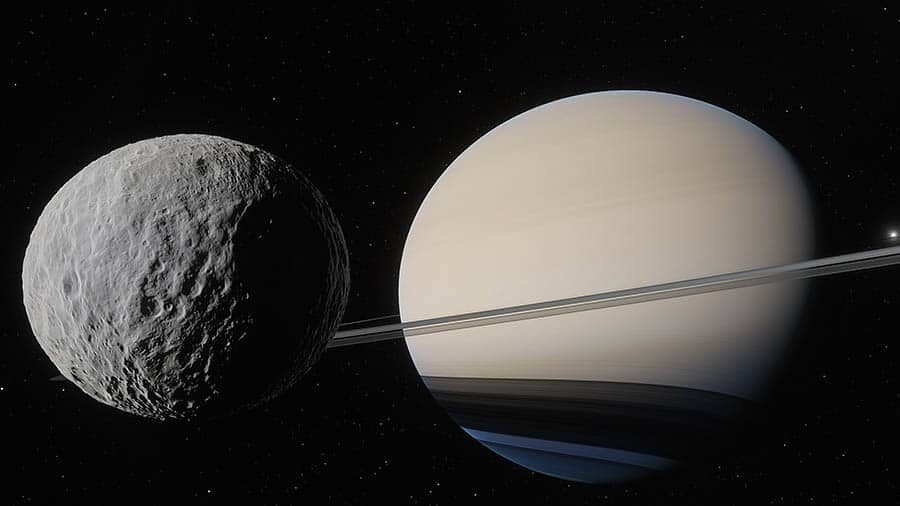10 Mimas Moon Facts | Great Facts about Mimas
If you’re looking to learn some facts about the moon Mimas, then you’re in luck. Mimas is one of the well known moons that orbits the planet Saturn, and it is one of the most well known too. Let’s look at some facts about the moon Mimas.

- Mimas has a radius of approximately 123 miles (198km).
- This makes it only 1/9th the size of the Earth’s moon, and approximately 1/300th the size of the planet Saturn.
- In fact, Mimas is the smallest object in our solar system that is still spherical due to it’s gravity.
- Mimas is very close to Saturn, as it is less than 115,000 miles (186,000km) away from the planet.
- This short orbital distance means that it only takes Mimas just over 22 and a half hours to complete one full trip around the planet.
- Mimas is named after the Son of Gaia (which means Earth) in Greek mythology.
- This moon was discovered in 1789 by astronomer William Herschel.
- The surface of Mimas is covered by different craters and chasms.
- The largest crater on Mimas is around 130km in diameter. It is named Herschel, after it’s discoverer,
- The temperature on the surface of Mimas is approximately -200°c.
Mimas is the son of Gaia in Greek mythology, which is where the moon Mimas takes it’s name. Mimas is one of the Giants, who was killed in the battle between the Giants and the Olympian Gods (Zeus etc), called the Gigantomachy. It’s said that Mimas was killed by one of Zeus’s lightning bolts. Mimas is mentioned in many different writings by various Romans too, like Seneca and Horace.
We know from the low density of Mimas that there is not much rock at the core of this moon – in fact, it’s density is so low that it suggests that much of this moon is probably water ice. Although Mimas is quite spherical, it still has an ellipsoidal shape – we know this taken from picture from the NASA mission called Cassini-Huygens.
We know much more about what is on the surface of Mimas that what it’s core is made from. As I mentioned, the largest crater on it’s surface is called Herschel, and it takes up a substantial part of this moons surface area. Herschel is as wide at 130km and as deep as 10km, and we know that from the size of this crater, it must have been a pretty big object that collided with it! In fact, astronomers think that if the object was much larger, then Mimas would have been destroyed completely. As well as craters on it’s surface, Mimas also has many chasms.
Well, we know that Mimas is the closest of Saturn’s major moons, and it’s also one of the smallest too. It orbits the planet in just under 24 hours, and during this time it is always facing Saturn – we call this being tidally locked to the planet.
If you’re a Star Wars fan, then you’re probably wondering why Mimas is referred to as the ‘death star’. However, it is quite easy to see why it has this nickname, as it does look like the Death Star from Star Wars. Even the large crater on Mimas, Herschel, looks like the indentation on the death star (this is actually where large super-weapons would be placed, but that’s a different story altogether!).
All in all, Mimas (or the death star) is the smallest major moon that orbits the planet Saturn. Although it is small, it has enough mass to create an almost spherical shape, and in the future, hopefully we can learn more about this small moon.